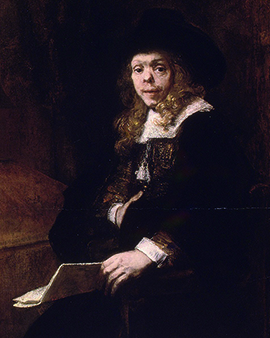


At the heart of the Dutch Golden Age was a much-admired artist named Gerard de Lairesse (1641 - 1711). His skills spanned music, poetry, and theater, but his particular passion and legacy lay in painting. He was a man whose work, influenced by Cesare Ripa and classical French painters, shaped the cultural panorama of the period. After Rembrandts death, Lairesse's importance grew and his writings on painting and drawing had a lasting influence on the artists of the 18th century. In this era of splendor and decadence, one could find high quality art prints in his studio that reproduced his stunning paintings. The roots of Lairesse's career as an artist were in the Dutch city of Liege, where he studied art under the supervision of his father and later under Bertholet Flemalle. It was a scandal that drove him from his hometown and took an unforeseen turn north, where he met his future wife Marie Salme and began a new life with her in Utrecht. Despite initial adversity, art dealer Gerrit van Uylenburgh recognized his exceptional talent and lured him to Amsterdam. With his talent for the violin in tow, Lairesse impressed the artists' colony. Soon after, he set to work on monumental paintings for Soestdijk Castle and the Loo Palace.
De Lairesse went beyond mere painting and found his way into the realm of art theory. The conditions that accompanied his congenital syphilis eventually forced him to abandon his painting when he went blind in 1690. Despite this setback, he found a way to maintain his influence in the art world by lecturing and recording his findings in two important art books, Grondlegginge ter teekenkonst (1701) and Het groot schilderboeck (1710). In these writings, de Lairesse expressed his disapproval of the realistic style used by Dutch painters of the Golden Age and stated his preference for sublime biblical, mythological, and historical scenes. In these books we find one of the first attempts to determine the ideal place for hanging paintings in interiors, and the importance of proportion and scale when viewing art.
Despite his criticism of some of his contemporaries, de Lairesse was an inspirational figure for many young artists, including Jan van Mieris, Simon van der Does, and the Teodor brothers and Krzysztof Lubieniecki. His influence on the art scene has been seen in the works of artists such as Jan van Mieris, Simon van der Does, and the brothers Teodor and Krzysztof Lubieniecki, who were influenced by his teachings and works. Even today, his works and writings are considered milestones in Dutch art history, showing both his influence as an artist and his impact as a thinker and theorist. It was his legacy, through both his paintings and his writings, that helped lead Dutch painting into a new age and expand the boundaries of art during a time of cultural flourishing.

At the heart of the Dutch Golden Age was a much-admired artist named Gerard de Lairesse (1641 - 1711). His skills spanned music, poetry, and theater, but his particular passion and legacy lay in painting. He was a man whose work, influenced by Cesare Ripa and classical French painters, shaped the cultural panorama of the period. After Rembrandts death, Lairesse's importance grew and his writings on painting and drawing had a lasting influence on the artists of the 18th century. In this era of splendor and decadence, one could find high quality art prints in his studio that reproduced his stunning paintings. The roots of Lairesse's career as an artist were in the Dutch city of Liege, where he studied art under the supervision of his father and later under Bertholet Flemalle. It was a scandal that drove him from his hometown and took an unforeseen turn north, where he met his future wife Marie Salme and began a new life with her in Utrecht. Despite initial adversity, art dealer Gerrit van Uylenburgh recognized his exceptional talent and lured him to Amsterdam. With his talent for the violin in tow, Lairesse impressed the artists' colony. Soon after, he set to work on monumental paintings for Soestdijk Castle and the Loo Palace.
De Lairesse went beyond mere painting and found his way into the realm of art theory. The conditions that accompanied his congenital syphilis eventually forced him to abandon his painting when he went blind in 1690. Despite this setback, he found a way to maintain his influence in the art world by lecturing and recording his findings in two important art books, Grondlegginge ter teekenkonst (1701) and Het groot schilderboeck (1710). In these writings, de Lairesse expressed his disapproval of the realistic style used by Dutch painters of the Golden Age and stated his preference for sublime biblical, mythological, and historical scenes. In these books we find one of the first attempts to determine the ideal place for hanging paintings in interiors, and the importance of proportion and scale when viewing art.
Despite his criticism of some of his contemporaries, de Lairesse was an inspirational figure for many young artists, including Jan van Mieris, Simon van der Does, and the Teodor brothers and Krzysztof Lubieniecki. His influence on the art scene has been seen in the works of artists such as Jan van Mieris, Simon van der Does, and the brothers Teodor and Krzysztof Lubieniecki, who were influenced by his teachings and works. Even today, his works and writings are considered milestones in Dutch art history, showing both his influence as an artist and his impact as a thinker and theorist. It was his legacy, through both his paintings and his writings, that helped lead Dutch painting into a new age and expand the boundaries of art during a time of cultural flourishing.
Page 1 / 2






